Samsung Galaxy Note 3 Review
by Brian Klug on October 1, 2013 9:00 AM EST- Posted in
- Smartphones
- Samsung
- Mobile
- Android 4.3
- galaxy note 3
Cellular and WiFi
With the advent of MSM8974 comes the third generation of Qualcomm’s LTE modem, in this case what 8974 brings over the second generation is new Category 4 LTE (up to 150 Mbps on the downlink) over the previous generation’s Category 3 maximum, 3GPP release 10 carrier aggregation, up to 3 carriers of HSPA+ aggregated, and of course the requisite CDMA 1xAdvanced/EVDO, GSM/GPRS/EDGE.
Of course it’s up to each operator and handset maker to make their own decision regarding what features they want implemented via the choice of frontend RF components, and in the case of the Note 3 those insights will really have to wait until someone tears one down. I suspect however that with the Note 3 Samsung marches even closer to a single worldwide SKU or at least fewer SKUs for each region. In the case of the T-Mobile Note 3, there’s disclosure for the banding that I would expect in the FCC documents, Bands 2, 4, 5, and 17 LTE are supported, at minimum, I wouldn’t be surprised to see 7 and 20 also supported in the same hardware. I strongly suspect we’re looking at a situation similar to the SGS4 where there was shared platform and front end between AT&T, T-Mobile, and Canada. I haven’t had time however to go through and look at all the Note 3 variants and their banding, and as usual Samsung doesn’t disclose their band combinations up front.
Without 20 MHz FDD LTE to test on T-Mobile, there’s not much we can really say about Category 4 in the context of the Note 3 review. In other markets with 20 MHz FDD LTE however this will open up additional throughput headroom that some already are up against.
The Note 3 continues to have Samsung’s great ServiceMode option for looking at signal characteristics like RSRP, channel bandwidth, and forcing whatever bands you want. However Samsung did remove the unlock shortcuts that were popularized for the previous Galaxy S series and Notes through the debugging screens and phone control menu. This also happens at the same time Samsung has started region locking devices.
As devices move closer to being truly universal with more LTE bands, I wouldn’t be surprised to see more of this kind of arbitrary locking being used to keep operator verticals in place and protect markets.
I had no issues with the Note 3 in both 5 MHz FDD LTE markets like NYC where I did some of my testing, and my home market in Arizona which is 10 MHz FDD LTE on T-Mobile.
Antenna placement on the Note 3 is pretty pragmatic as well, at least on this variant. One big main antenna for transmit on all the bands supported by the hardware, and a second diversity antenna for LTE and WCDMA.
A big new thing in the Note 3 is the inclusion of a component from Qualcomm’s RF360 portfolio, the QFE1100 envelope power tracker, making it the first device to do so. This reduces overall thermal footprint and power consumption on the RF front end by varying the voltage across the power amplifier (which previously was a fixed DC voltage) to match the waveform of the transmitted signal. The envelope tracker essentially is a power supply with a closed loop between the baseband and the power amplifier, which enables the power amplifier to closely follow the desired transmitted waveform. Envelope trackers help mitigate the power waste that comes with high peak to average power ratio inherent to OFDMA (LTE) by closely matching the power amplifier voltage supply to the output signal. This allows the power amplifier to work much closer to the peak of its power added efficiency (PAE) curve, especially when the input signal envelope is low, by tracking the amplitude of the input signal.


ET (Envelope Tracking), and APT (Average Power Tracking) on Note 3
Watching ServiceMode on the Note 3 is a real treat since you can see PA State change between a few different modes, APT/PT/ET which I suspect translate to average power tracking, power tracking, and envelope tracking modes, again confirming the presence of the power tracker. Qualcomm has a post up about the QFE1100 and its use in the Note 3.
GNSS
With 8974 also comes another newer version of Qualcomm’s GNSS (Global Navigation Satellite System) software suite. The previous generation (GNSS Gen 8/8A) included support for GPS and Russia’s GLONASS system. The new one onboard 8974 and forward moves to GNSS 8B which includes support for GPS, GLONASS, and China’s Beidou constellation.
At present there’s no way for me to validate whether Beidou support is working on any of the 8974 phones I have, because the coverage for that constellation is not global but rather limited to a slice in the Asia-Pacific region. I’m not aware of any other improvements inside GNSS 8B, but Qualcomm’s GNSS has always been excellent for me, locking quickly even indoors or in urban canyon scenarios. The Note 3 performs very well and locks quickly and I don’t have any issues to speak of.
WiFi
I didn’t expect much to change on the Note 3 from SGS4 in terms of WiFi connectivity, but I got an interesting surprise. Instead of the BCM4335 combo which was ubiquitous in this last round for WiFi/BT/FM radio, there’s the newer generation BCM4339 combo which integrates the necessary power amplifiers and front end components for a lower cost solution.
BCM4339 is still a single spatial stream part with support for 802.11a/b/g/n/ac, and on 802.11ac support for up to 80 MHz channels with 256QAM under MCS9, for a PHY rate of 433.3 Mbps, which is what we’ve seen before with 4335. Again what’s new is the integration of the 2.4 and 5 GHz power amplifiers for transmit and low noise amplifiers the receive chain, as well as the other necessary front end components, although handset makers can still choose to support their own external ones. This drives integration cost down and hopefully means 802.11ac will find its way into more places.
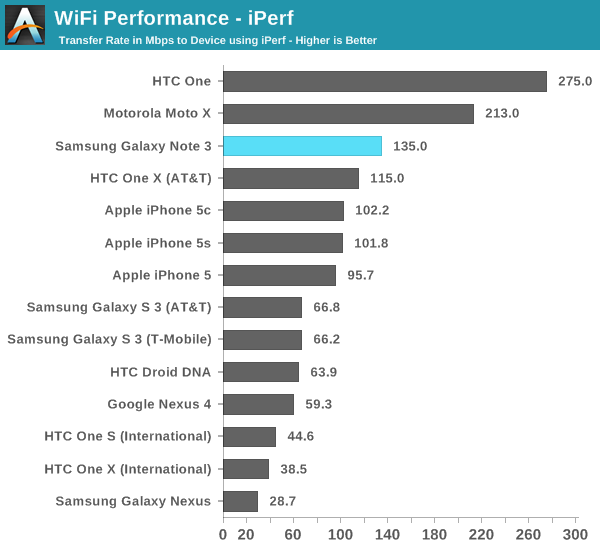
I tested the Note 3 using iPerf the same way I have other phones for a while now and saw some weird behavior. WiFi throughput during my test jumped around quite a bit and even on the 433 Mbps PHY rate the maximum sustained rate I could get was around 135 Mbps. Still very fast, but not quite up as high as some of the other 802.11ac phones I’ve tested.
I don’t like that there’s no band preferences option under the advanced menu anymore, although this seems to be a thing operators want removed (which makes no sense to me, but whatever). The Note 3 does add an auto network switch toggle which seems to be a feature Qualcomm has added to its BSP lately to allow for intelligent switching between WiFi and cellular when the WiFi network you’re attached to isn’t delivering any packets. I also noticed that the Note 3 will shut down the data session for cellular when you’re attached to WiFi as well to cut down on power use, something a few other vendors have done for a while.
Speaker and Noise Rejection
With the Note 3, Samsung changes up the normal speakerphone location dramatically, from the back side coming out of the battery cover to a new place blasting out the bottom lip of the Note 3 through a grille. I tested speakerphone on the Note 3 the same way I have other devices, by placing a call, cranking volume up to maximum, and using a data logging sound pressure meter to record and average the entire call.
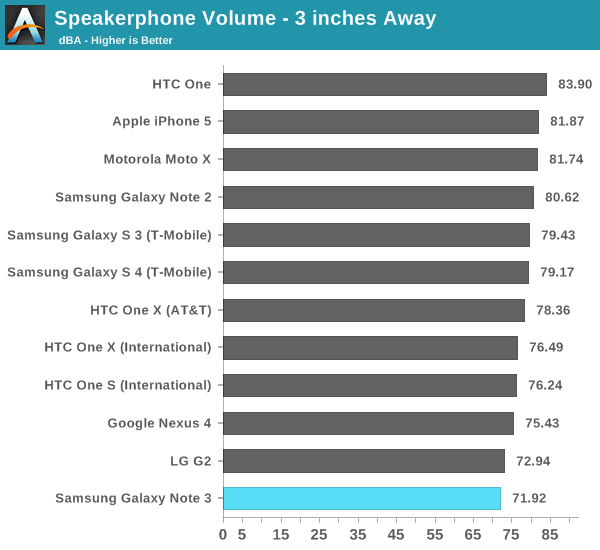
Oddly enough, speakerphone is very quiet on the Note 3 and isn’t nearly as loud as SGS4. More puzzling, tapping the extra volume button doesn’t seem to do anything at all if you’re attached to WiFi, however the button works if you’re not attached to WiFi (and thus the background data connection is enabled). This seems like a bug to me, as it’s very quiet compared to the competition, and unfortunate since part of the Note 3 is that expectation of a great multimedia experience with the big display.
A big change in the Note 3 is the inclusion of a new generation of Audience voice processor, the Audience eS325 which we’ve talked about before, which includes support for using three microphones for ambient noise reduction. Interestingly it turns out the SGS4 had 3 microphones and this same solution, but only ever used them in pairs (the third was next to the earpiece and only used during speakerphone calls). The Note 3 has three very visible microphones, one at top, one at bottom, one on the bottom right side.
Audience enables noise reduction on narrowband (8kHz), wideband(16kHz), and super wideband (24kHz) calls with this new generation with the three microphones. This new solution also adds de-reverb which helps reduce the reflections audible when calling from an enclosed room, something the previous generation didn’t have.
To test I ran through the same test we’ve done in the past, I speak into the handset in front of speakers playing a babble distractor track up to a certain sound pressure level, and then back down. I added in a speakerphone mode (far talk) mode as well just for comparisons, with the noise reduction toggle that Samsung makes available in the phone dialer toggled on and off, for comparisons. I called between a T-Mobile Galaxy S 4 and the Note 3 on T-Mobile, which gave us 12.65 kbps AMR-WB (“HD Voice”) voice call, in a spectogram of the recording we can also see components above the 4 kHz filter for a normal narrowband voice call (narrowband is again 8 kHz sampling, AMR-WB uses 16 kHz sampling, after nyquist we pass 4 kHz and 8 kHz respectively).
The eS325 does a good job rejecting the babble track without rejecting a lot of the incoming voice or making me sound distorted. I’m always impressed that anything is audible at the maximum volumes as these are literally so loud I can’t hear myself talking into the handset and probably not conditions normal people would call under anyways. Noise rejection on these larger phablet or Note sized phones is also a challenge since the microphone pairs are far apart and the mouth is physically further from the microphones than they normally would be, so I’m impressed with overall performance considering those constraints.


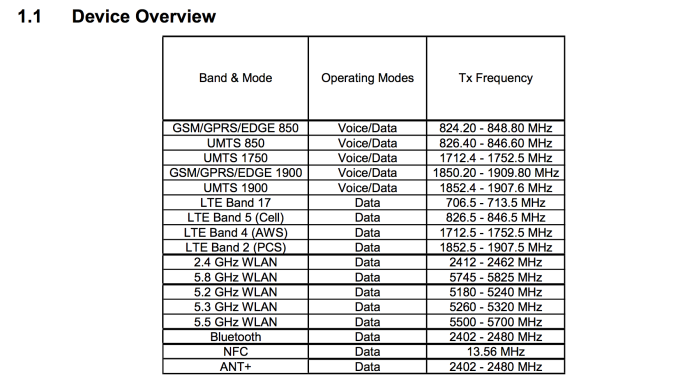
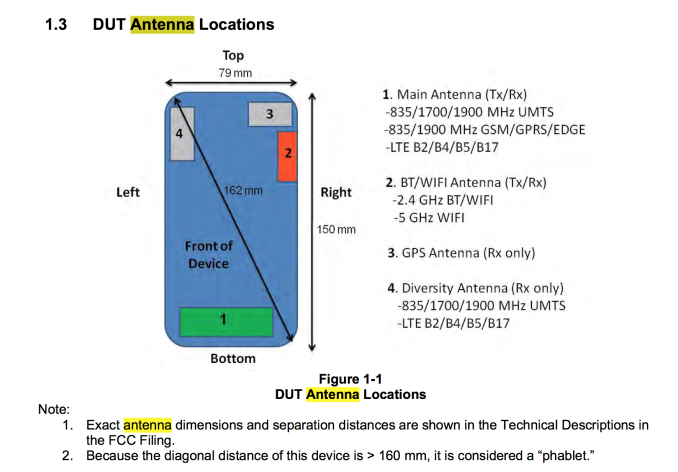
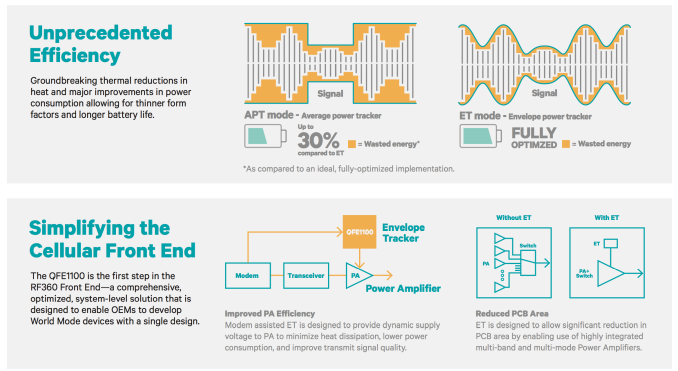


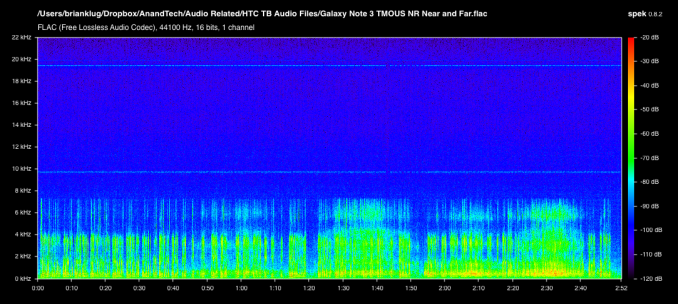








302 Comments
View All Comments
jerry_carter - Wednesday, October 2, 2013 - link
Making a mockery of "The Most Trusted in Tech Since 1997"Anand:
I appreciate your site and reviews and have read religiously for several years now. That stated, the most recent Samsung review [1] falls significantly below your traditional journalistic standards. I use the word 'journalistic' because you've earned it -- working independently when possible and calling out limitations when forced to work within them. You've historically identified significant issues in several products and revised articles or reviewed products when these issues were corrected.
With the Samsung review, you have failed to meet these standards. I accept your comments that benchmarks from several products are suspicious. That is no reason to not take a harder line with each and every case that you encounter. I have no problem with posting the 'manufacture optimized' numbers provided that they are presented in parallel with numbers for with the optimizations are disabled (or believed to be disabled). I do appreciate that this is more work, but your site, Ars Technica, and others can expose corruption (or as least bad behavior) where it occurs and motivate manufactures to 'do the right thing. And really, isn't that what journalism is about?
Thanks for your work over the last several years. I trust that the review will be corrected soon and look forward to that and future work in the months and years ahead.
Best Wishes,
Jerry Carter
[1] http://www.anandtech.com/show/7376/samsung-galaxy-...
ccd2 - Wednesday, October 2, 2013 - link
The popularity of the new iPhone is really amazing. With the maturity of the phone market, the trend seems (to me at least) to be away from a one phone does all to a number of segments. The Note 3 represents one of those segments (I own the Note 2). If I were in the market for a phone, the Note 3 would be my phone. My guess is that, in time, phones like the S4 which I would consider a kitchen sink phone where everything is thrown in, will give way to more phones like the Note 3, which are designed for market segments. My guess is that most people who buy a phone like the Note 3 would not give the iPhone or Galaxy S4 a second look. That is no knock against Apple before the fanboys jump on me. It's just that with a bigger screen, S pen, etc., the Note has a different focus and appeal. You can already see other potential segments like where the phone is more camera than phone. To me, this seems where the phone market is headed as it continues to mature.SeriousTodd - Wednesday, October 2, 2013 - link
Brian, if you could comment on the subject of legitimacy of this website, it would be great.http://www.displaymate.com/OLED_Galaxy_S123_ShootO...
SeriousTodd - Wednesday, October 2, 2013 - link
Brian, it would be great if you could comment on the subject of legitimacy of this website.http://www.displaymate.com/OLED_Galaxy_S123_ShootO...
ChrisMars - Wednesday, October 2, 2013 - link
Great review, thanks!May I propose to adapt the CalMan results graph in a way it's more easy to grasp at a glance?
Just putting the best on top would be a improvement already.
Adding a line at 6505K for white-point deviation would also be good to improve readability,
SpacedCowboy - Wednesday, October 2, 2013 - link
Just one more voice added to the cacophony.I started reading anandtech a long time ago - so long that I don't remember exactly when. The nature of the reviews here caught my eye, and I became a fan. What I liked was how things were made bare, with intelligent guesses (always noted as such) and astute observations leading to conclusions that other sites just didn't provide. Over time, the track record was excellent and trending better.
Now, though, you've just taken a huge step back. Some points:
1) It's not an insignificant difference between the cheating and non-cheating modes as you suggest in the review. Perhaps there's something else going on rather than just locking the clock to fMax - perhaps they're relaxing the thermal envelope as well. Who knows ? It's all very dodgy.
2) It's all very well to say that benchmarks don't mean anything, but a lot of people who don't really know what they want, but just "want the best phone" are going to look up a review on the internet, see which phone is at the top of the graphs, and assume that's the best one, then go out and buy it. Tech-savvy customers are the exception, not the rule, and you've just given Samsung everything they wanted.
3) You say you're struggling with how to react. I'm struggling to see why you're struggling. If someone cheats, you call them on it; simple as that, and you make the cheating the major point of any review. Naming and shaming manufacturers, and the commensurate bad PR is the only way we'll stop them (and by 'we' I mean sites like your good selves).
The only reasons I can see why you wouldn't do this is that you're afraid that you'll lose access to new products in future, or you're being paid to shill their products. If it's the former, well, that's a story in its own right; if the latter (which FYI, I don't believe to be the case), then a sad day has dawned and I'll go somewhere else for my tech reviews.
4) I don't care who does it, be it Apple, Samsung, HTC, whatever - name them and shame them. Cheats should never prosper.
You're in a privileged position. You've gained that position because of your reputation and hard work, by doing the journalistic version of speaking truth to power. It just seems so ... sad ... that you didn't hold yourselves to your previous high standards this time, and I guess we're all just a bit shell-shocked and asking "why ?"
TL;DR: Such a shame.
cozmot - Friday, October 4, 2013 - link
Very good points, and that sums my thoughts up perfectly.Arbie - Wednesday, October 2, 2013 - link
"How is it cheating if everyone does it?" -- First off, it's cheating because it's intentionally misleading; and secondly because not everyone does it. The companies who are not cheating are being shown in a falsely bad light. And I wouldn't have known that from reading this Anandtech article.So Anandtech really needs to highlight the fact in the same chart that presents the results. Or better yet, omit Samsung scores on that parameter and say why.
Samwise - Wednesday, October 2, 2013 - link
Anandtech, please review the Droid MAXX.apljack80 - Wednesday, October 2, 2013 - link
I think I have read enough of these posts to feel like many of your words are an unwarranted attack of the writers of Anandtech. Let me be perfectly clear, Samsung and other OEMs DID NOT CHEAT, and ANANDTECH DID NOT LET THESE COMPANIES OFF THE HOOK. Let me articulate why this is the case.1) First you must look at the device and it’s intended purpose. These are phones not laptops or desktops, that for the most part enjoy an unending stream of power. These phones are designed to sip power with extreme efficiency. As a result, they do this at the cost of unleashing the full potential of the hardware of the phone, in order to optimize the full potential of the battery. Consider all of the effort they have taken to make more powerful CPU’s, GPUs, and bright huge screens use so much less power than their predecessors, think about how much they have accomplished with all this AND make a phone last almost all day.
2) All of these phones are also very efficient crushing the full potential of the hardware, however, a benchmark is testing the efficiency of the hardware not the battery. And this causes benchmarks to become ARTIFICIALLY LOW. So when faced with this issue the OEM’s have made provisions, to allow the device to fully unleash it’s full potential in the code. Try thinking of it like this, Samsung did not improve its scores by adding that code, but let us see what the actual power of the processor is. Other implementations of the same hardware are lower, because the software and power saving devices are forcing it to be slower. That is why you are seeing these ‘special’ cases, because you could not see what the real ability of the phone is without the code.
3) I believe the writers of Anandtech understand this at some level, and lack the ability to truly communicate that message to the masses. If you read their articles, they do feel it is a form of cheating, but have not called it in any way a lie. They walk a fine line between being honest with themselves, and offending a company that sends them devices for review. So they have to be careful in how they word things, and in this case I felt their response was diplomatic to say the least. They did not ignore what is happening like other tech sites, they acknowledged it and reported their raw numbers. The raw numbers that the phone can actually do outside of it’s limitations.
I am embarrassed at what I have seen here today, and I am embarrassed by all of you who have failed to engage you minds on this topic. Think before you speak, you will find more doors will open to you that way. And be grateful they have even replied to any of us during this tirade.